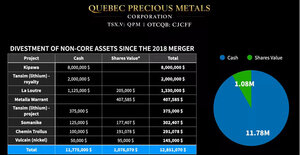The Gold Report: Sid, in your interview with The Gold Report in February you said gold could creep back down to around $750 an ounce by 2012 if there is a strong economic recovery in the U.S. Has anything in the last eight months changed your mind?
Sid Rajeev: We have made some revisions to our forecast, but our overall outlook on the market and gold has not changed. We were expecting a gradual recovery in the U.S.; however, the recovery has been much slower than expected. The housing and labor markets continue to be weak. We have been seeing a lot of mixed results in the past six months. These factors have created a lot of uncertainties in the market. Gold most often is the answer for uncertainty, which is why gold prices are at such high levels.
Even though the recovery has been slow, we believe that the U.S. is in a much better position than it was last year. Unemployment levels have dropped. It's now close to 9.6% versus more than 10% last year at this time. The stock market is a leading indicator—the TSX Venture Exchange is up 29% year over year. These are signs of improvement.
We continue to believe the economy will grow gradually, which could lead to more stability and a drop in investment demand for gold. We still believe that gold prices should soften in the next two to three years as there is a gradual recovery in the U.S. However, we have increased our long-term gold price forecast from $750 to $900 in 2013 primarily due to the higher cash costs of new gold projects.
TGR: What do you see in the near term? Gold prices have had an amazing run this week, hovering around $1,300. What do you see through the end of the year into early 2011?
SR: Uncertainty is the main factor keeping gold prices high. Gold is always in demand when there's a high level of uncertainty. It's tough to say when the market is going to stabilize and when the uncertainty might die down. We definitely expect to see some stability in the market as the U.S. economy recovers over the next six to twelve months.
TGR: Do you think gold prices will cross the $1,400 threshold by the end of the year?
SR: Short-term movements are hard to predict. We might see spike in prices. However, as the market improves and stabilizes, there are fewer incentives for investors to keep holding onto gold. They would rather take the money out of gold and put it in investments with potential to offer higher returns.
TGR: If gold prices fall to $900 as you're forecasting, successful companies will need to have lower cash costs and greater efficiency than a lot of operations work at right now. What are some companies that fit that thesis?
SR: Two good examples are Gold Resource Corporation (OTCBB:GORO; FSE:GIH) and SilverCrest Mines Inc. (TSX.V:SVL), both of which produce gold and silver.
Gold Resource announced commercial production in July at its El Aguila Project in Mexico. It's looking at 70,000 ounces per year production in the first year, increasing to 200,000 ounces by year three. The interesting thing is that the company is expecting a cash cost of $200 per ounce in the first year, which would drop to $0 per ounce in the third year. That's because they believe that all the operating costs can be offset by base metal credits, or the copper, zinc and lead they can produce along with the gold and silver. We have a BUY rating on the company with a fair value of $19.40.
SilverCrest just completed its first pour of gold and silver in its Santa Elena Property in Mexico. The company is looking at production of 35,000 ounces gold, 600,000 ounces silver and a mine life of eight years. They have probable reserves and indicated resources of a half-million ounces of gold and 24 million ounces of silver. Their average cash cost is expected to be $375 per ounce of gold equivalent.
TGR: Vincent, what's your position on Mexico as a jurisdiction?
Vincent Weber: There are still a lot of exploration possibilities there. Mexico is one of the best places for companies to find some great deposits right now. It's still an area that I think people should have confidence in.
TGR: In our last interview, you talked about Evolving Gold Corp. (TSX.V:EVG; Fkft:EV7). Recently, Evolving had some good drill results from its Rattlesnake Hills Project in Wyoming. The company got some more good news when Goldcorp Inc. (NYSE:GG; TSX:G) took a position. Goldcorp now owns about 15% of Evolving, but its share price is languishing. What's the update on Evolving Gold?
VW: Evolving is actually trading at more than twice what it was when we initiated coverage in June 2009. Overall, the stock has had some volatility.
There's obviously quite a bit of excitement with the Rattlesnake Hills discovery. We have to remember that Rattlesnake Hills and the other exciting property in Nevada's Carlin Trend are quite early-stage projects. The company has only really been drilling on Rattlesnake Hills for about two years. Evolving just began drilling at Carlin this year.
The company has continued to show that there are areas of low-grade, bulk-style mineralization, plus high-grade areas at Rattlesnake Hills. At Carlin, the company is finding gold mineralization in carbonate rocks.
TGR: There's no NI 43-101 resource yet on either?
VW: The company hasn't put out an NI 43-101 resource yet. Evolving has done a lot of drilling, but not every company puts out an NI 43-101 within six months of starting on a project. The way that we look at it is—it's likely obvious that Goldcorp has seen the intimate details of the projects. They probably feel as though Evolving is still undervalued. That's an opinion that we would certainly share.
TGR: What are some attributes you like about the company?
VW: I like the management. The company is run by President and Chief Geologist Quinton Hennigh and Chief Executive and Director Robert Barker.
TGR: Wasn't Quinton involved with Newmont Mining Corp. (NYSE:NEM) on a mine in the Carlin Trend before?
VW: Yes, I believe he was.
SR: Evolving Gold certainly has a strong management team. It also has a strong cash position. After this discovery, we saw the stock increase from $0.40 to about $2. Now it's at close to $0.90.
The results that came out initially were fantastic. It's tough to maintain those kinds of results on a long-term basis, and that's one of the reasons why the stock has dropped to $1. We still believe the deposit has very high potential. We expect the stock to move up closer to our fair value estimate of $1.40 per share as the company continues to advance the project.
TGR: The share price of Rio Alto Mining Limited (TSX.V:RIO; BVL:RIO; OTCQX:RIOAF), which has a significant copper/gold project in Peru, has more than doubled since you talked about it in February. Copper/gold deposits are in high demand right now given the excess smelting capacity in China. Is there more upside on Rio Alto?
VW: There's still plenty of upside. We initiated coverage at an excellent time. Rio Alto was just going through the early stages of getting started on the La Arena deposit.
Typically, the share price of a junior mining company increases after an initial discovery. The share price will usually decrease as the company goes through the actual financing and development stages, and then start climbing back up as it goes toward production.
The company is still planning on putting the first ore on the leach pad this month, with the first gold production sometime early next year. I would expect that, once Rio Alto produces its first end product, people will fully realize the strength of the company.
TGR: What guidance is the company giving on gold production through the first quarter of 2011?
VW: It's a heap-leach operation, so there won't be any specific gold production this year. The company wants to finish construction and just get the actual stuff on the leach pad, and then it takes a couple of months for the gold to get produced. Rio is targeting 50,000 ounces of gold for year one once they get things rolling.
TGR: The company's current resource is 2.8 million ounces indicated and another 1.2 million ounces inferred, plus that doesn't take copper into account.
VW: Rio Alto just released (initial results from) an (upcoming) update to the technical report yesterday (September 15, 2010) that includes updated resources, reserves and financial estimates. The company was able to move a bunch of the resources into reserves, both in oxide and sulphide.
TGR: Does that set them up as a takeover target?
SR: Yes, it's definitely a good takeover target, especially because Rio Alto has now reached a stage where there is lot of information on its project. Majors typically wait for the juniors to spend all the money, explore, do all the hard work and come up with positive economics—that's when companies look extremely attractive for acquisition. We definitely think Rio Alto is a good candidate.
The majors typically wouldn't want to wait until a bankable feasibility study is completed, which is the final stage before production, as the market price of those targets would be much higher at that stage.
TGR: They probably also want to see the results of the heap leaching, too, and if they're getting as much gold as they've projected?
SR: Right.
TGR: So, you could probably see something early next year after the ounces come out in the first quarter?
SR: The next six months should be extremely exciting for the company.
TGR: What are some other plays that you're following and excited about?
VW: Harvest Gold Corp. (TSX.V:HVG). This company has its flagship Rosebud Project in northern Nevada. Drill results from some previous operators have shown that a lot of high-grade intersections were close to the areas that were mined underground but still remain in place. The company released some drill results recently that show there's a halo of lower-grade, bulk tonnage-type mineralization. This company has an opportunity to delineate a possible bulk-tonnage target with high-grade pods in it.
We also like Monument Mining Ltd. (TSX.V:MMY). This company just had its first gold pour at their Selinsing Gold Mine Project in Malaysia in November 2009. During the past year, the company has been working to increase its operations toward full production. Monument's plant capacity is 400,000 tons per year (tpy) and its production outlook is 40,000 ounces in the first year.
In April 2010, FRC initiated coverage on Andover Ventures Inc. (TSX.V:AOX). Andover's near-term focus is on upgrading historic resources at the Burgin Mine and restarting production at the Trixie Gold Mine, both located in the East Tintic Mining District of Utah. Historic resources at the past-producing Burgin Mine total 73.5 million ounces (Moz.) of silver, 3.3 billion pounds (Blbs.) of lead and 3.3 Blbs. of zinc.
There's also Merrex Gold Inc. (TSX.V:MXI), which has projects in west Mali, Africa. There's a lot of good geology there—Birimian Greenstone Belts hosting relatively high-grade stuff that's often at or near surface. Merrex is in a joint venture with IAMGOLD Corporation (TSX:IMG; NYSE:IAG), which did a private placement with them last year. Recently, IAMGOLD took over operatorship. Merrex continues to hold a 50% interest in the project.
TGR: The whole thing is being funded by IAMGOLD and Merrex is sort of along for the ride?
VW: It certainly must be an advantage to have a company like IAMGOLD running your operation, I would think.
TGR: Are there some drill results coming out soon?
VW: They just put out some good drill results in August. The Birimian sequences typical of West Africa host the gold mineralization in long, relatively narrow trends. The company just extended continuous mineralization in two parallel trends over a distance of 3 kilometres.
TGR: The price of silver has gained 22% this year and sits at just less than $21 an ounce. Sid, what's your view on silver prices through the end of the year and into 2011?
SR: Silver is unique because it tends to share the characteristic of gold as a capital preservation asset but is also like a commodity (such as copper, zinc or lead) due to its industrial applications. Silver tends to perform well during highly uncertain times, just like gold, and during periods of economic growth because of its industrial applications.
This is exactly what we're seeing now. We're seeing economic growth and a high level of uncertainty in the markets. These two factors combined are pushing silver higher, which is the main reason silver has outperformed gold.
At current prices, the silver:gold ratio is 62 times, which is well above the historical average of 54–55 times. It clearly shows that silver is priced at a premium compared to gold. Just like gold, investment demand for silver could drop with the economic recovery. Our long-term forecast for silver is $16.50, which is still way above the historical average.
TGR: Do you have any silver plays that you believe are poised to take advantage of those prices?
SR: Gold Resource and SilverCrest, which we discussed earlier. Both companies just went into production and produce silver and gold. Among the companies we cover, they are in the best position to exploit these prices.
TGR: What can you tell us about the uranium price and where it's headed?
SR: Of all the commodities, we are most bullish on uranium because its fundamentals have been very strong. We didn't really see an uptick in prices when all the other commodities moved in the past 6–12 months. However, in the past few months, uranium prices moved up by 20% from $40–$48 per pound. The fundamentals of uranium and its recently revived market interest should result in strong performance by companies with good projects.
Two companies that fall in that category are Strathmore Minerals Corp. (TSX.V:STM; OTC.PK SHEETS:STHJF) and Mawson Resources Ltd. (TSX:MAW). Mawson's stock has more than doubled since we initiated coverage in July. Strathmore Minerals stock is up 20% since we initiated coverage on Aug. 10.
Strathmore is a pure uranium story. The company is focused on advancing its Roca Honda uranium project—one of the largest planned uranium mines in the U.S. in more than 30 years—to production. Roca Honda has 17.5 million pounds (Mlb.) measured and indicated and 15.8 million inferred. The company owns several other properties with NI 43-101 and historic resources. Most importantly, Strathmore has a good management team and a strong cash position. It had more than $25 million in the bank this summer. We believe this is a very good, undervalued story.
TGR: Strathmore owns only 60% of the Roca Honda property; Sumitomo Corp. owns the other 40%. Does that compromise Strathmore's leverage to the uranium price?
SR: Definitely not. A junior company like Strathmore needs help, especially in terms of financial resources and expertise. We think this partnership is definitely good for Strathmore as they would be able to advance the project at a much faster rate.
TGR: And what do you like about Mawson, Vincent?
VW: Mawson Resources has quite a number of projects—gold and uranium—but its primary focus would probably be uranium in Scandinavia. It also has a gold project called Alto Quemado in Peru, which it just recently acquired.
The Rompas Gold-Uranium Project in northern Finland is pretty intriguing. Mawson obtained it when it acquired Areva's Scandinavian uranium package earlier this year. The Rompas property was originally discovered by Areva through some grab samples in 2008. The property had some pretty spectacular results.
In terms of the grab samples, the gold ranged from around 1,000–12,000 grams per ton (g/t). Uranium was also present in the same hand samples from 2.7% –24.9%. The hand samples were taken from structurally hosted hydrothermal veins within the property, so you know that mineralization is sourced on the property.
Because the property was just acquired, the company does have to go through the process of permitting. It hasn't been able to do much exploration yet, but I believe it will probably complete more extensive exploration sometime in 2011.
TGR: What's your outlook for the precious metals and uranium sectors, Sid?
SR: The commodity that we are most bullish on at this time is uranium. We expect uranium stocks to perform well in the next 12 months because most of the uranium stocks were fortunate to have raised a lot of capital when uranium was trading at record highs of $137 per pound few year ago. Right now, a lot of uranium stocks are trading close to its cash. So increasing interest in this sector could result in higher returns.
In terms of gold and silver, the unsettledness in the market and the slow recovery might keep prices strong in the near term. However, we expect the price of both gold and silver to soften—but not to historical lows.
TGR: Gentlemen, I'd like to thank you for sharing your expertise.
Siddharth Rajeev has been vice president and head of research at Fundamental Research Corp., an institutional research firm in Vancouver, since April 2006. Rajeev holds a bachelor of technology in electronics engineering from the Cochin University of Science & Technology and an MBA in finance from the University of British Columbia. He has also cleared all three levels of the CFA program and has completed studies in exploration and prospecting at the British Columbia Institute of Technology. Rajeev is ranked as a four-star analyst in the energy and mining sectors by Deutsche Asset Management, a division of Deutsche Bank. His picks in the energy and mining sectors in 2009 were determined to outperform their respective benchmarks after transaction costs. Previously, Rajeev worked in corporate finance at a leading investment bank in Kuwait.
Vincent Weber is a mining research associate at Fundamental Research. He graduated from the University of Waterloo in the interdisciplinary Honours Science and Business Program. He has conducted due-diligence site visits on mining projects around the world, from Peru to Canada.
Want to read more exclusive Gold Report interviews like this? Sign up for our free e-newsletter, and you'll learn when new articles have been published. To see a list of recent interviews with industry analysts and commentators, visit our Expert Insights page.
DISCLOSURE:
1) Jason Mallin of The Gold Report conducted this interview. He personally and/or his family own shares of the following companies mentioned in this interview: None.
2) The following companies mentioned in the interview are sponsors of The Gold Report: SilverCrest, Evolving Gold, Goldcorp, Rio Alto, IAMGOGOLD and Strathmore.
3) Siddharth Rajeev: I personally and/or my family own shares of the following companies mentioned in this interview: None. I personally and/or my family am paid by the following companies mentioned in this interview: None.
4) Vincent Weber: I personally and/or my family own shares of the following companies mentioned in this interview: None.I personally and/or my family am paid by the following companies mentioned in this interview: None. FRC provides fee-based coverage to some of the companies mentioned in this article.











































